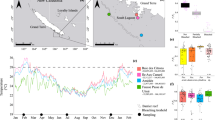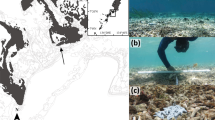Abstract
The effect of used drilling muds on coral health was examined by monitoring changes in calcification rate and soluble tissue protein concentration in the coral Acropora cervicornis. Exposure to 25 ppm (v/v) of one mud for 24 h reduced calcification rate in the growing tips by as much as 62%. In recovery experiments, corals were exposed to drilling muds for 24 h; some of them were allowed to recover in clean seawater for 48 h. After the 24-hour exposure, calcification rates were significantly less than those of the controls. After a 48-hour recovery period, calcification rates returned to control levels for one mud but were still significantly below control levels for another. The results indicate that the capacity for recovery after exposure cannot be predicted from the results of experiments on exposure only. Recovery capacity must be independently verified for all studies on the effects of short-term exposure to drilling muds.
Similar content being viewed by others
References
Amende LM, Pierce SK (1980) Structural changes of Noetia ponderosa red blood cell membranes during cell volume regulation in reduced salinities: a freeze fracture study. J Comp Physiol 138:299–306
Artigue WJ (1980) Drilling operations-offshore. In: Research on environemental fate and effects of drilling fluids and cuttings, proceedings, vol 1, Lake Buena Vista, Florida, pp 12–14
Baden SP (1982) Impaired osmoregulation in the shrimp Palaemon adspersus exposed to crude oil extract. Mar Pollut Bull 13:208–210
Baden S, Hagerman L (1981) Ventilatory responses of the shrimp Palaemon adsperuss to sublethal concentrations of crude oil extract. Mar Biol (Berl) 63:129–133
Bak RPM (1978) Lethal and sublethal effects of dreging on reef corals. Mar Pollut Bull 9:14–16
Bak RPM, Elgershuizen JHBW (1976) Patterns of oil-sediment rejection in corals. Mar Biol (Berl) 37:105–113
Bak RPM, Es YS (1980) Regeneration of superficial damage in the scleractinian corals Agaricia agaricites f. purpurea and Porites astreoides. Bull Mar Sci 30:883–887
Barnes DJ, Crossland CJ (1977) Coral calcification: sources of error in radioisotope techniques. Mar Biol (Berl) 42:119–129
Barnes DJ, Crossland CJ (1980) Diural and seasonal variations in the growth of a staghorn coral measured by time-lapse photography. Limnol Oceanogr 25:1113–1117
Benson AA, Muscatine L (1974) Wax in coral mucus: energy transfer from corals to reef fishes. Limnol Oceanogr 19:810–814
Chalker BE (1976) Calcium transport during skeletogenesis in hermatypic corals. Comp Biochem Physiol A 54:455–459
Chalker BE, Taylor DL (1975) Light-enhanced calcification, and the role of oxidative phosphorylation in calcification of the coral Acropora cervicornis. Proc R Soc London Ser B 190:323–331
Clausen CD, Roth AA (1975) Estimation of coral growth-rates from laboratory 45Ca-incorporation rates. Mar Biol 33:85–91
Conklin PJ, Doughtie DG, Rao KR (1980) Effects of barite and used drilling muds on crustaceans, with particular reference to the grass shrimp Palaemonetes pugio. In: Research on environmental fate and effects of drilling fluids and cuttings, proceedings, vol 2, Lake Buena Vista, Florida, pp 912–943
Cooke RJ, Roberts K, Davies DD (1980) Model for stress-induced protein degradation in Lemna minor. Plant Physiol 66:1119–1122
Dillon TM, Lynch MP (1981) Physiological responses as determinants of stress in marine and estuarine organisms. In: Barrett GW, Rosenberg R (eds) Stress effects on natural ecosystems. Wiley, New York, pp 227–241
Dodge RE, Aller RC, Thomson J (1974) Coral growth related to resuspension of bottom sediments. Nature (London) 247:574–577
Dodge RE, Vaisnys JR (1977) Coral populations and growth patterns: responses to sedimentation and turbidity associated with dredging. J Mar Res 35:715–730
Ducklow HW, Mitchell R (1979) Bacterial populations and adaptations in the mucus layers on living corals. Limnol Oceanogr 24:715–725
Egana AC, DiSalvo LH (1982) Mass expulsion of zooxanthellae by Easter Island corals. Pac Sci 36:61–63
Engel DW, Fowler BA (1979) Copper and cadmium induced changes in the metabolism and structure of molluscan gill tissue. In: Vernberg W, Calabrese A, Thurberg F, Vernberg F (eds) Marine pollution: functional responses. Academic Press, New York London, pp 239–256
Goreau TF (1964) Mass expulsion of zooxanthellae from Jamaican reef communities after Hurricane Flora. Science 145:383–386
Goreau TF, Goreau NI (1959) The physiology of skeleton formation in corals. II. Calcium deposition by hermatypic corals under various conditions in the reef. Biol Bull (Woods Hole Mass) 117:239–250
Hudson JH, Robbin DM (1980) Effects of drilling mud on the growth rate of the reef-building coral, Montastrea annularis. In: Geyer RA (ed) Marine environmental pollution, vol 1: Hydrocarbons. Elsevier, New York Amsterdam, pp 455–470
Hudson JH, Shinn EA, Robbin DM (1982) Effects of offshore oil drilling on Philippine reef corals. Bull Mar Sci 32:890–908
Hutchinson TC, Hellebust JA, Mackay D, Tam D, Kauss P (1979) Relationship of hydrocarbon solubility to toxicity in alagae and cellular membrane effects. In: Proceedings of the 1979 Oil Spill Conference (prevention, behavior, control, cleanup). American Petroleum Institute, Publ No 4308, pp 541–547
Jaap WC (1979) Observations of zooxanthellae expulsion at Middle Sambo Reef. Florida Keys. Bull Mar Sci 29:414–422
Jaap WC, Wheaton J (1975) Observations on Florida reef corals treated with fish-collecting chemicals. Fla Mar Res Publ 10:1–17
Jeffries HP (1972) A stress syndrome in the hard clam, Mercenaria mercenaria. J Invertebr Pathol 20:242–251
Kasschau MR, Meyn RE (1981) Recovery of Chinese hamster cells from mercuric chloride exposure. J Toxicol Environ Health 7:9–18
Kendall JJ JR, Powell EN, Connor SJ, Bright TJ (1983) The effects of drilling fluids (muds) and turbidity on the growth and metabolic state of the coral Acropora cervicornis, with comments on methods of normalization for coral data. Bull Mar Sci 33:336–352
Knowlton N, Lang JC, Rooney MC, Clifford P (1981) Evidence for delayed mortality in hurricane-damaged Jamaican staghorn corals. Nature (London) 294:251–252
Koenig ML, Powell EN, Kasschau MR (1981) The effect of salinity change on the free amino acid pools of two nereid polychaetes, Neanthes succinea and Leonereis culveri. Comp Biochem Physiol A 70:631–637
Krone MA, Biggs DC (1980) Sublethal metabolic responses of the hermatypic coral Madracis decactis exposed to drilling mud enriched with ferrechrome lignosulfanate. In: Research on environmental fate and effects of drilling fluids and cuttings, proceedings, vol 2, Lake Buena Vista, Florida, pp 1079–1100
Lawrence DR, Scott GI (1982) The determination and use of condition index of oysters. Estuaries 5:23–27
Low RB, Leffingwell CM, Bulman CA (1980) Effects of kaolinite on amino acid transport and incorporation into protein by rabbit pulmonary alveolar macrophages. Arch Environ Health 35:217–223
Loya Y, Rinkevich B (1980) Effects of oil pollution on coral reef communities. Mar Ecol Prog Ser 3:167–180
Mitchell R, Chet I (1975) Bacterial attack on corals in polluted seawater. Microb Ecol 2:227–233
Moseley HR JR (1980) Drilling fluids and cuttings disposal. In: Research on environmental fate and effects of drilling fluids and cuttings, proceedings, vol 1, Lake Buena Vista, Florida, pp 43–52
Muscatine L (1971) Calcification in corals In: Lenhoff HM, Muscatine L, Davis LV (eds) Experimental coelenterate biology. University of Hawaii Press, Honolulu, Hawaii, pp 227–238
Muscatine L, Cernichiari E (1969) Assimilation of photosynthetic products of zooxanthellae by a reef coral. Biol Bull (Woods Hole Mass) 137:506–523
Neff JM (1981) Fate and biological effects of oil well drilling fluids in the marine environment: a literature review. Final report to the US EPA Environmental Research Laboratory, Gulf Breeze, Florida
Neff JM, McCulloch WL, Carr RS, Retzer KA (1980) Comparative toxicity of four used offshore drilling muds to several species of marine animals from the Gulf of Mexico. In: Research on environmental fate and effects of drilling fluids and cuttings, proceedings, vol. 2, Lake Buena Vista, Florida, pp 866–881
Perricone C (1980) Major drilling fluid additives-1979. In: Research on environmental fate and effects of drilling fluids and cuttings, proceedings vol 1, Lake Buena Vista, Florida, pp 15–29
Peters EC, Meyers PA, Yevich PP, Blake NJ (1981) Bioaccumulation and histopathological effects of oil on a stony coral. Mar Pollut Bull 12:333–339
Peterson GL (1977) A simplification of the protein assay method of Lowry et al., which is more generally applicable. Anal Biochem 83:346–356
Pickering AD, Pottinger TG, Christie P (1982) Recovery of the brown trout, Salmo trutta L., from acute handling stress: a time-course study. J Fish Biol 20:229–244
Powell EN, Connor SJ, Kendall JJ JR, Zastrow CE (1984) Recovery by the coral Acropora cervicornis after drilling mud exposure. The free amino acid pool. Arch Environ Contam Toxicol 13:243–258
Roberts HH, Rouse LJ JR, Walker ND, Hudson JH (1982) Cold-water stress in Florida Bay and northern Bahamas: a product of winter cold-air outbreaks. J Sediment Petrol 52:145–155
Roth AA, Clausen CD, Yahiku PY, Clausen VE, Cox WW (1982) Some effects of light on coral growth. Pac Sci 36:65–81
Rubinstein NI, Rigby R, D'Asaro CN (1980) Acute and sublethal effects of whole used drilling fluids on representative estuarine organisms. In: Research on environmental fata and effects of drilling fluids and cuttings, proceedings, vol 2, Lake Buena Vista, Florida, pp 828–846
Searcy WA, Yasukawa K (1983) Sexual selection and red-winged blackbrids. Am Sci 71:166–174
Shinn EA, Hudson JH, Robbin DM, Lee CK (1980) Drilling plumes from offshore drilling operations: implications for coral survival. Geyer RA (ed) Marine environmental pollution, vol 1: Hydrocarbons. Elsevier, New York Amsterdam, pp 471–496
Squires EJ, Hall DE, Feltham LAW (1979) Seasonal changes in plasma amino acid levels in the winter flounder (Pseudopleuronectes americanus). Can J Zool 57:1438–1442
Thompson JH, Bright TJ (1977) Effects of drill mud on sediment clearing rates of certain hermatypic corals. In: Proceedints of the 1977 Oil Spill Conference (prevention, behavior, control, cleanup). American Petroleum Institute, Publ No 4284, pp 495–498
Thompson JH JR, Shinn EA, Bright TJ (1980) Effects of drilling mud on seven species of reef-building corals as measured in the field and laboratory. In: Geyer RA (ed) Marine environmental pollution, vol 1: Hydrocarbons Elsevier, New York Amsterdam, pp 433–454
Young SD, O'Connor JD, Muscatine L (1971) Organic material from scleractinian coral skeletons. II. Incorporation of 14C into protein, chitin and lipid. Comp Biochem Physiol B 40:945–958
Author information
Authors and Affiliations
Rights and permissions
About this article
Cite this article
Kendall, J.J., Powell, E.N., Connor, S.J. et al. The importance of monitoring metabolic recovery in the coral Acropora cervicornis after short-term exposure to drilling muds: Calcification rate and protein concentration. Coral Reefs 2, 215–225 (1984). https://doi.org/10.1007/BF00263575
Received:
Accepted:
Issue Date:
DOI: https://doi.org/10.1007/BF00263575




